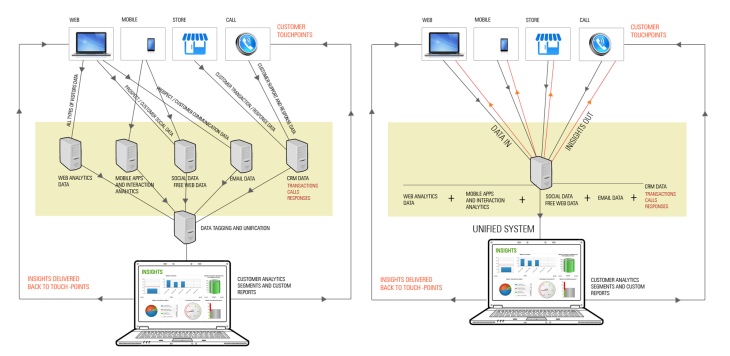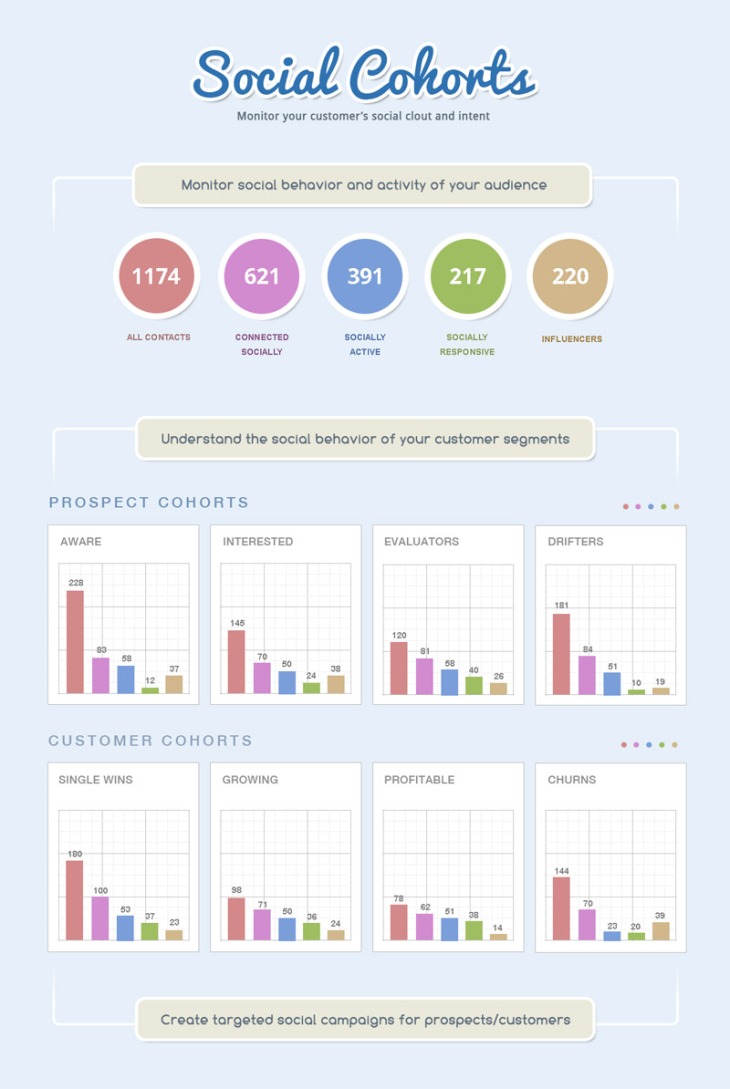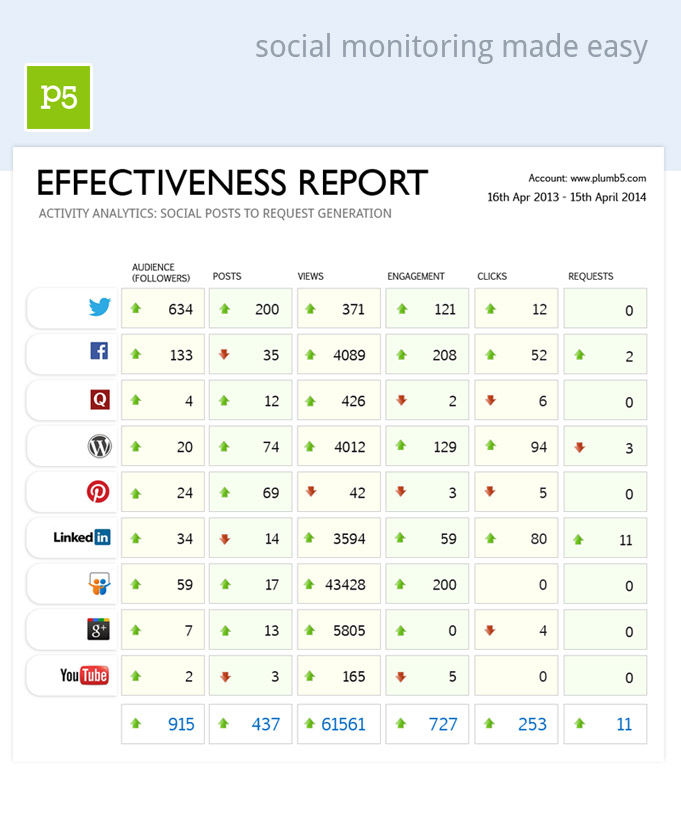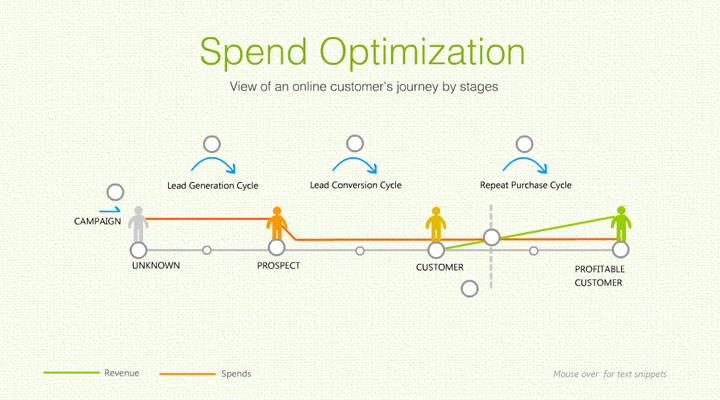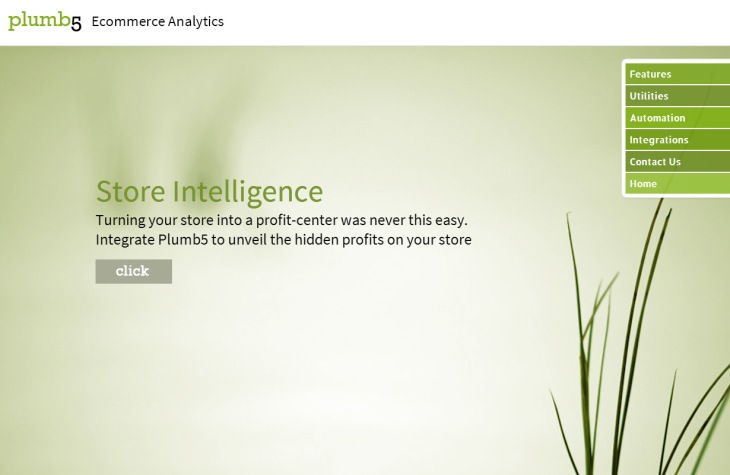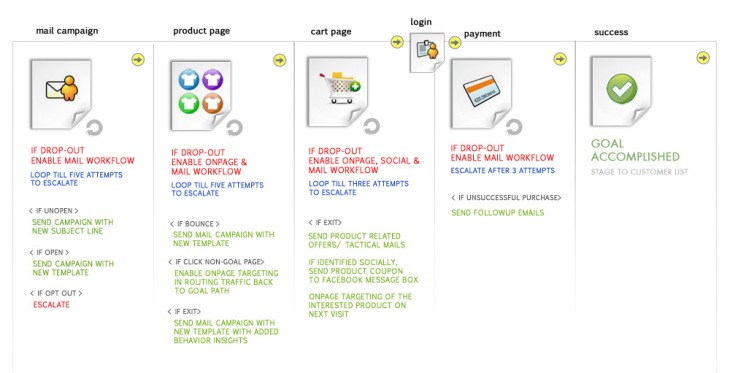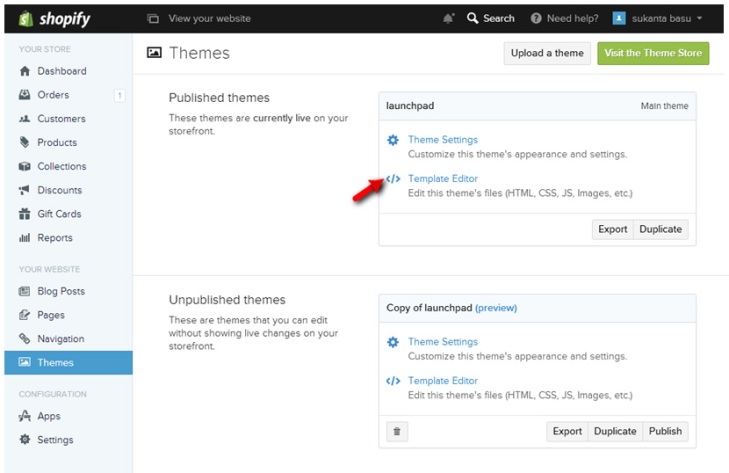Autonomous Customer Engagement can be defined as an engagement (either interactions or conversation) between a customer (human) and a machine. The machine is capable of engaging the customer, just like how human agents do. They create memories and hence can remember past events and co-relate it with current events. They learn, decide, predict and recommend just like the way humans do. And to an extent behave like sales agents, ensuring customer satisfaction, offering better deals and following up on purchases, with a goal to achieve higher customer retention and more revenue per customer. Continue reading →

Real-time Personalized Recommendations
Customer experience personalization is all about data first. Get the data right and you can shape the overall customer experience by applying insights learning. Recommendation engines are very powerful personalization tools because it’s a great way to discover what products they like, what their preferences are and so on. They help in enhancing visitor’s experience by offering relevant items at the right time and on the right page.
The importance of suggesting the right item to the right user can be gauged by the fact that 35% of all sales in Amazon are estimated to be generated by the recommendation engine. The core strategy accounts for more revenue per customer through predicting recommendations that a user is likely to buy, which they might not be aware before. Continue reading →

Optimizing Digital Ad Spends
In order to measure ROI on Ad Spends(ROAS), it is important to track the entire journey of the ad visitor up to the point of purchase. This could happen either on their first visit or during subsequent visits. Measuring conversions, or measuring interest generated by a particular ad, is dependent on the interactions that happen post clicking the ad. By filtering out bot traffic, one can identify the right channel that drives visitors with intent. Continue reading →
Walking through Plumb5 Analytics
Plumb5 Web and Mobile Analytics covering Visitors, Sources, Content analytics along with Scoring, Segmentation, and Goals
Explainable AI: Visualizing and Interpreting Machine Learning
Machine learning algorithms operate in a so-called black box — so the inputs and outputs are known, but how or why an algorithm makes the recommendation it does is not clear. Despite the AI media frenzy, companies and governments are concerned about the machine learning black box. The EU’s General Data Protection Regulation, which takes effect next year, includes a right to explanation clause, or an explanation of how a model made a decision.
The Explainable AI (XAI) program aims to create a suite of machine learning techniques that:
- Produce more explainable models, while maintaining a high level of learning performance (prediction accuracy); and
- Enable human users to understand, appropriately trust, and effectively manage the emerging generation of artificially intelligent partners.
New machine-learning systems will have the ability to explain their rationale, characterize their strengths and weaknesses, and convey an understanding of how they will behave in the future. The strategy for achieving that goal is to develop new or modified machine-learning techniques that will produce more explainable models.
How to setup Visitor Engagement in 5 minutes
A demo to showcase how a marketer can set up engagement campaigns with just a few clicks. You can test it yourself at http://widgets.plumb5.com/
Rule Based Personalization Using Dynamic Templates
The video demonstrates how 1:1 personalization campaign can be configured using tags in dynamic templates
Customer Engagement Using AI
It could be said that in the near future, customer engagement which encompasses product marketing, query handling, customer support can be handled by machines without much human intervention.
Customer Marketing, Sales, and Support, which is mostly built on communication, is always a dialogue between a particular customer and the brand. This human dialogue (interactions) is mostly about seeking information about your brand, or negotiations before purchase or after sales queries or issues, managed by support teams. Continue reading →
Evolution of Data Model in Plumb5
From generating real-time insights from data inputs from a couple of touch-points to automating business processes over holistic business data, the Plumb5 data model has come a long way. What started as a customer-as-the primary-key design for data collected from marketing touch-points is now scaled to incorporate every data parameter of the business, with customer key still in the center.
The data model design now lends itself to real-time learning over unified 1:1 customer data, which allows the machine to automate next steps in a business process using synthesized intelligence.
Reference links to understand real-time AI capabilities of the platform
- Real-time Pattern Detection
- Real-time Recommendations
- Real-time Recommendations using NLP
- How Autosegmentation work?
- How Behavior Scoring works?
- Automation routines
Offline Targeting with Enhanced App Analytics
In today’s mobile world, marketers need to find new and innovative ways for their app to stand out from the crowd – beyond the download. Millward Brown Digital survey (August 2016) revealed that 43% of US smartphone owners use only four to six apps on an average day. Considering that the average person has 55 apps installed on their person’s device, your app has to work hard to compete for user attention. The same study found that 72% of smartphone owners deleted an app because they rarely used it. These statistics underline the importance of mobile engagement to actively retain and engage users.
For many mobile marketers, it can be challenging to measure KPIs, such as Customer Lifetime Value (CLTV) and Average Revenue per User (ARPU), effectively. Each app platform has its own restrictions and device identifiers, which complicates the situation. Marketers need to work with multiple SDKs to measure the right KPIs. Continue reading →
Evaluating the right AI Platform for your business
As businesses are increasingly laying their focus on artificial intelligence solutions, it might be important to understand what goes into implementing these solutions.
Most business product and solutions have now taken to the tone of customer satisfaction, making every solution look the same. It’s only a matter of time, that they will all offer or at least speak about artificial intelligence. I would assume, it would become increasingly difficult for the businesses to understand the truth behind these systems. Continue reading →
Understanding Logical Data Model in Plumb5
An EDM (Enterprise Data Model) is the starting point for all data system designs. It falls in the realm of information architecture. The model can be compared with an architectural blueprint is to a building; it draws up visualization, as well act as a framework supporting planning, building and implementation of data systems. This helps in planning your data integration and takes away the data silos. With this, the unified data present the “single version of the truth” for the advantage of all. It minimizes data redundancy, disparity, and errors; core to data quality, consistency, and accuracy.
Evaluating a Cloud Analytics Platform?
Businesses are looking to scale beyond descriptive and predictive analytics apps by finding analytics platforms capable of propelling to the upper levels of the Intelligence Maturity Model.
According to SelectHub’s Selecting the Best Cloud Analytics Platform, Majority of companies today are locked in the lower layers of the Intelligent Cloud Maturity Model. Using analytics apps that only deliver descriptive analytics is like trying to drive forward by staring in the rearview mirror.Enterprises need to push analytics platform providers to develop and launch machine learning, advanced prescriptive and cognitive analytics. When this happens, companies will be able to see how the timing of a decision during a given financial period makes a major difference in outcomes.Best of all, there will less guessing and more knowing about why a given strategy or business model is succeeding or not.
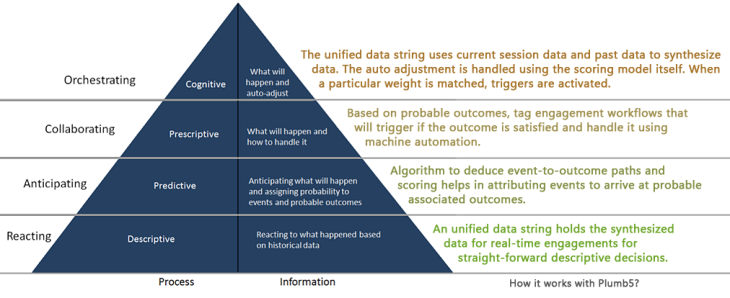
Plumb5 Platform allows businesses to implement a solution that can elevate them to a much intelligent environment to manage their customers and bring a substantial difference in their outcomes. Continue reading →
Customer State Machine
With customers using multiple touch-points, it is very important to engage them at every touch-point with relevance and context. In order to do that to every single customer, you have to resort to machine driven intelligent automation, which can learn and compute from past and present behavior in order to create true context and relevance in every customer’s experience.
So a state machine automation that can understand the state of the customer (by computing customer stages, behavior and interactions) can look at a rule book to perform the next action (personalized message) and collect responses to update the behavior. Using the concept of customer strings, this loop automation constantly updates the string in real-time. The string which is consumed by touch-points, have access to real-time insights of every single customer
Using these concepts, Plumb5 Platform allows business to configure engagement automation and create an instant personalized experience for their customers. The below deck features slides with deeper insights about the approach

Business Operating System w/ Customer State Machine
Having a strong, integrated Business Organisation System (BOS) can determine the success of a company as it begins to grow. A robust BOS – a standardized set of processes followed across all business functions – helps a company successfully scale its operations. The best example of this is the success of the franchise model that has worked wonders for businesses like McDonalds, KFC, etc. Building a sound BOS into the fabric of the company itself will help build a strong brand and enable it to transcend the capabilities of individual managers.
Business Organisation Systems used to be determined by factors like industry best practices, regulatory requirements, and legislations. Now, with technology radically altering workplaces and the way businesses function, BOS is determined by advancements in technology and communication systems. In today’s technology-driven workplace, software platforms are central to developing a standardized BOS to streamline work processes and build a solid operating workflow.
In-App Chat for customer engagement in real-time
Chatting with your app users is the most effective way to engage app users. Chatting with your customers help build meaningful relationship and enables deeper engagement and conversions leading to increased sales. It is important to personalize and recommend based on the needs of individual customer
Be it a retail app or a food ordering app or a taxi booking app, there are finer instances of customer experience, where they are either looking for a shirt with a specific collar or food that needs less salt or requesting a custom taxi package. These queries need human interaction and can be best addressed with a real-time chat.
To make app engagement more effective, app developers can enable chat on their mobile applications, without going through a new feature development cycle.

Customer Engagement on Mobile Apps
Customer engagement has become such a priority that many businesses have agreed that it will be their primary driver of growth and productivity. This means that customer facing teams will be working closer than ever to find new and innovative ways to engage with customers across multiple touch points.
Today, customers demand more efficient and user-friendly experiences throughout the whole customer life cycle. Mobile apps give business many opportunities to improve the customer experience and to engage with customers. At the forefront of improving customer experience is context based user personalization
Plumb5 Platform allows marketers to track and engage customers on mobile apps and integrate interaction data to the unified stack, so that you can get full view of the customer which helps in strategizing the next actions and goals on your mobile app. Using the platform, marketers can engage their customers with personalized messages or through in-app chat Continue reading →
Inbuilt Features in Plumb5
If you are a Plumb5 user, some of the inbuilt functions that you should apply to your data for accurate results and data automation. Continue reading →

AI driven business automation
Driving Business Automation using artificial intelligence
The Plumb5 V6 Platform will allow businesses to automate customer-centric business processes with its supervised AI enabled decision systems
The Plumb5 V6 Platform will feature intelligent automation in two important areas; (a) Customer Engagement, (b) Digital Assistants
In the area of Customer Engagement, Plumb5 will provide learning and intelligence in the areas of Dynamic UI Personalization, Behavioral Learning based Engagement Automation, Recommendations and Targeting based on emotional behavior for video enabled sessions
The Digital Assistants can be used to answer customer queries on digital touch-points (website/mobile app) or on the phone (call center). Digital Assistants can be used internally by organizations to generate reports on the fly or predict scenarios.
Real-time BI Platform
Plumb5 doubles up as Real-time Marketing Automation and Business Intelligence Platform, helping businesses solve growth problems on the fly
Customer-brand connection makes good business sense
Engaging customers with brands is an effective way of understanding their purchasing behavior. It also helps delve deep into their nature and get an insight into their idiosyncrasies, when it comes to making a choice about a particular product or service in the market. Incidentally, it is also an exercise that can be as tough a nut to crack as it gets.
Customer engagement
Understanding human mind has never been easy. Often the manner in which a customer engages at a given point of time may not be the true reflection of his or her inner self. It is also not rare that a customer appears to be reluctant to engage but turns out to be a genuine buyer, subsequently.
Marketing ploy
Marketers, therefore, find customers’ brand engagement such an important marketing ploy for analyzing their behavior. This helps them work out a long term outlook for products and services from the perspective of customers’ satisfaction and their purchasing frequency. Continue reading →

Mobile Personalization and Engagement
Modern marketers understand that mobile apps are far more effective than SMS or mobile-optimized emails and are now using mobile apps as the priority touch-point to engage customers with personalized messaging. With more users buying online, businesses are working towards building their own app where they can engage their mobile customers more effectively.
Marketers are focused on data insights and personalization, along with effective app design to improve their customer engagement rate. Tracking SDKs are effectively used to get behavior insights of the target audience which can be used to understand user behavior and strategize contextual messages
App Notifications can solve problems of getting your customers to remember your app, understanding their usage flow, creating goal based usage pattern and rewarding them with personalized gifts. Solving these problems can triple retention and engagement rate
According to a Gartner study, rational customer engagement through systematically ‘teaching’ your customers to make the best use of your products, is one of the key ways for developing an appropriate deep understanding of the products
Plumb5 Mobile SDK helps marketers to track and engage customers on their mobile apps. Plumb5 tightly ties mobile behavior and web behavior, which allows the marketer to seamlessly visualize each customer behavior across both active touch-points.

Put Your Stationery Ecommerce on the Move
Stationery items once were limited to schools and colleges for the purpose of reading and writing. From pencils, erasers and notebooks, stationery items have moved on to notepads, designer and customized notebook covers and pencil boxes, stick-on notes, staplers, pins, pens, ink-pots, rulers, and the list goes on.
To some, stationery items are foundation of learning, and for others they are source of pouring thoughts out, to jot down ideas or an add-on to their memory power; with time, the functionality of simplest and smallest things have developed dimensions of purpose and popularity.
Beacon Marketing is good
With the rise of the mobile-empowered consumer, innovative marketers are using beacons to create more compelling, personalized customer experiences at the store and department level. Every in-store mobile experience that is delivered to a shopper must be relevant to the interests and behaviors of that shopper, and must provide clear value to the consumer
The Digital Insurer
Banking back with the bank
Performance Dashboards
Using Plumb5 data discovery and decision tool, we can build performance metrics by integrating data from external sources. Using the tool, businesses can create custom dashboard to monitor their overall performance based on the needs. To illustrate the utility, we have created a HTML mock, which gives a quick overview of performance related to Customers, Products, Conversions, Spends and Revenue.
Click here to view the HTML Mock.
Unified tracking across customer touch-points
To achieve real-time delivery of customer insights, marketers need to adapt tracking touch-point interactions using unified scripts. Unified scripts helps in maintaining single trackers which runs on all possible touch-points so as to keep a single stack of all customer actions irrespective of the touch-point
Why Unified Tracking is important?
To improve efficiency of your campaigns, you have to seriously work on getting real deep insights of the customer. The best way to collect information about your customer, is to listen to your customer at all touch-points. That’s the closest you can get to your customer.
Touch-point data expose us to user’s behavior covering interactions, responses, sentiment, and transactions
SMAC Stack vs Unified Stack
Businesses are looking at implementing SMAC solutions in order to transform their digital business. If the objective was to get more insights into the business so that you can optimize customer centric processes and spends, then SMAC solves only a part of it. The Unified stack is much more agile and solves most customer centric problems, as the fundamentals of the unified architecture is to align and store data by individual customers
Unified Stack Architecture will help marketers align with 1:1 communication with every customer, which are the most targeted steps in conversion marketing. The stack also helps marketers understand and measure their marketing spends accurately and enables real-time tracking of revenue and spends
But in the case of SMAC Stack, it picks data from different silos, and attempts to tag it based on available identifiers, and makes room for insight leaks and data redundancy, also due to its unstructured nature. But in the Unified Stack, data is tagged at the touch-points (client application) with necessary parameters.
The most important aspect of Unified Stack is that data tagging starts at the customer touch-point and extends across all other touch-points by maintaining a unified document for every customer, irrespective of the touch-point.
Effective targeting can cut down customer acquisition costs
Customer Acquisition can be far more cost effective if marketers employ growth hacking techniques. Most of the growth hack techniques involve identifying and targeting prospective buyers, based on the info available on the free web and getting connected on an one-to-one basis to share marketing messages.
Reverse combing is a variant of growth-hack technique to acquire customers effectively by way of effective targeting. This technique does not believe in high volume advertising but works on a fixed target, which is proportional to maximum delivery potential of the business.
Machine Driven Marketing
Email Marketing with Insights and Automation
Click here to read how email insights can bring about effectiveness?
The Importance of Social in your Omnichannel Strategy
Social plays an important role in your omni-channel Strategy. Not only does it serve as a channel for periodic brand alerts ensuring brand recall, but can also be scaled to communicate and engage prospects and customers and convert these engagements to purchases. Facebook Notifications can be used to engage signed up users, which promises a high open rate for your messages
It would be important to understand your social users; whether they are just followers or prospects or even customers in order to push highly relevant messages that carries high probability of conversion. To create relevance in messages, it would be necessary that we look through their journey and behavior in other channels of that particular user.
Plumb5 Integrated Omnichannel platform allows marketers to understand which of their users (prospects and customers) are active socially and allows them to configure triggers to send personalized campaigns on social channels (facebook, twitter, and others). The responses of these campaigns are recorded and integrated back to the omni-channel journey. This gives the marketer a holistic picture in terms of the user behavior on social channels in comparison to other channels within the user journey and be able to attribute time and efforts spent to measure effectiveness.
The Dashboard on Plumb5 Social App gives the marketer a quick preview of the social cohorts. The Cohorts (User Groups) created within your lead management tool or your CRM is integrated with the social app to understand which of these users have a public social handle. Using the social handle, an invitation can be sent to the user to join the social app.
Social Monitoring: Effectiveness Report
Measuring the social effectiveness of the campaigns shared on social sites: The above report shows how Plumb5 fared across social sites and which channel paved the way for requests/lead generation. The report does not include metrics from paid campaigns and this is created to measure the effectiveness between paid and organic campaigns.
Plumb5 integrates with the web-services of the social sites, to aggregate analytics and reports the holistic view of your social effectiveness.
Multichannel Attribution with Probabilistic Model
Definition:
The purpose of marketing attribution is to quantify the influence each advertising impression has on a consumer’s decision to make a purchase decision, or convert.
Attribution is the process of identifying a set of user actions (“events”) that contribute in some manner to a desired outcome, and then assigning a value to each of these events. Marketing attribution provides a level of understanding of what combination of events influence individuals to engage in a desired behavior, typically referred to as a conversion.[Src: http://en.wikipedia.org/wiki/Attribution_(marketing)]
Attributing value to events such as clicks, allows marketers to optimize media spend for conversions and compare the value of different marketing channels, including paid and organic search, email, affiliate marketing, display ads, social media and more
Current Challenges
1. Since channels include Ad sources, organic search, mail and social sites, data identification is not consistent across all sources.
Continue reading →
Increasing ROI by optimizing spends
The scenario depicted is of an online customer, who uses web store, mail, social pages, loyalty and other web based customer touch-point apps, as he interacts with the brand or product. Click the image to get information in detail
Spend Optimization
Plumb5: Store Intelligence
Click to visit our e-commerce site to get a quick view of its features, utilities and platform integrations
http://ecom.plumb5.com/
Conversion Automation
Integrating Plumb5 to your store enables automation on your store. You can setup workflows to automate lead generation, lead conversion and retention campaigns, by using rules and scores. This enables constant communication with the audience on both web and email touch-points
Lead Conversion Example
Illustrated above is an example of lead conversion workflow (first purchase), where automation is implied from the first communication using a qualified mailing list, till the stage where the goals are met. The automation can be configured to escalate after a set number of attempts to minimize drifting prospects
Plumb5 integrates with major commerce platforms
Connect your ecommerce store API to your Plumb5 account and start monitoring visitor behavior on your stores and run personalized campaigns based on behavior and interactions
Sync SalesForce contacts with your Plumb5 account
You can synchronize your SalesForce contacts by just configuring the API access and token. The contacts will be available in Plumb5 Contact base, where you can start engaging them through mail and onsite campaigns. Now, you have access to the contacts behavior and social preferences. You can segment your contacts based on behavior and run personalized campaigns to monitor responses.
Setting it up
Log in to your Plumb5 account and click on the manage account link to get to the configuration tab
Enabling customer click-stream on your Shopify Store
Here is a quick two step configuration, which shows how to tag customer id to sessions, recorded on Plumb5
Select “Themes” from the left hand menu to get to the template editor.

Data Foundation for AI Implementation
AI is a simple science of being able to decide and carry out functions in real-time just like how human workers do
Just like the way human brain makes decisions, systems that can create a memory of patterns can quickly detect/recognize patterns from past memories, allowing them to make decisions which can be translated to predictive decisions, recommendations or the shortest path to the goal. Based on the status of these states, the system fires the next appropriate function, which could be an engagement with a customer or an insight to a marketer.
This simple mechanism allows the user to observe every step of the learning process, keeping the system transparent and agile. Without transparency, your AI investments could be a very risky proposition Continue reading →

Remembering past interactions is critical for engagement automation
How does the customer engagement system or the marketing automation platform know the past behavior or preferences of your customer? Does it have a memory? Is it making decisions based on past experiences?
To initiate true AI driven customer engagement, it is important that the system learn and create a memory file around each customer. This has to be constantly updated after every interaction so that memory consolidation and references are maintained, and accessible to any touch-point application in runtime.
The memory files will allow the machine to truly behave like a human: exhibiting relevance and context in its communication and driving customers towards their goal. These memories can be easily integrated with customer engagement applications to make them aware of customer states and preferences; helping them deliver highly effective communication and reducing the time to revenue.
This is exactly how Plumb5’s Memory Stack is designed to perform real-time contextual customer engagement. By ingesting individual customer data (created by the unification feature), Plumb5 extracts spatial and temporal patterns to arrive at states based on weight attribution, creating individualized memories. It also checks for similarities in other individual’s memories and creates collective memory states, before creating/updating the final memory file(output file).
The Plumb5 Unified Customer Stack, which forms the foundation to these memories, collects data from all data sources or data lake or data warehouse and creates a single customer file based on tags and unique identifiers. The Unified Stack, which is nothing but a centralized data repository of all individual customers (i.e., a transformed and harmonized dataset), has all the data parameters required to analyze/learn or make decisions.
The data repository contains each customer’s explicit or implicit data collected through touch-point applications. This individual stack, when extracted, presents the relationship between the customer and all other input parameters spanning products, channels, campaigns, feedback and other. On further extraction, we can find a relationship between the customer and associated factors from product interactions, or channel responses or preferences associated with the customer id, forming spatial relationships.
These relationships are converted to a set of tags with their own weights, which is used to understand the importance of the relationships in order to to prioritize the next best action. The weights can also be used to arrive at the nearest neighbor for firing a new event For the purpose of analysis, one can cluster customers based on these tags and their weights
This data, when laid out sequentially by time, presents the temporal pattern of the individual: allowing one to predict the next probable direction of the customer.
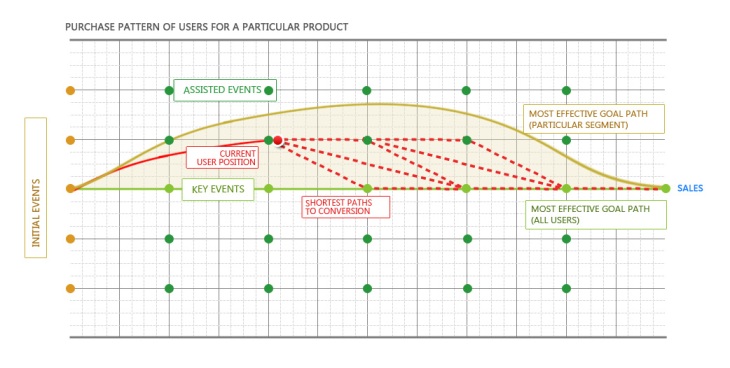
Both spatial and temporal relationship weights are combined to arrive at the net weight, which updates the final individual memory states. These memory states or patterns of a single individual are compared with other individual stacks and patterns to arrive at collective memory states; important for predicting recommendations or probable next actions based on similar profiles.
All of these states are consolidated into a single string (JSON) as memory states. On the collection of data from data sources, these memory states are updated at runtime using continuous-time Markov decision processes, allowing the string to keep updated information at all times. These strings can be consumed by customer engagement platforms for real-time contextual and relevant engagement.
These memory files will make it simpler for the proliferating customer touch-point space. With more businesses wanting to track, collect or engage customers using IoT devices, data needs to be organized for quick extraction of information and for runtime analysis and decision generation. The memory file will make it simpler for any such device that requires it to present quick relevant communications.
Currently, the robots deployed for customer service have no consolidated data about a customer and merely serve to answer generic questions. To take robotic customer service to the next level, these robots will need to have access to memories to make customer service far more contextual and relevant.
These memory files can also be integrated with NLP tags, where contextual conversation can be carried out at runtime, exhibiting to a complete AI based contextual experience for every customer or visitor.
How Intent States work in Plumb5?
Intent Scoring helps in understanding customer’s possible intent towards a product, which can be used in personalizing content or offers based on his intent state. The state can be identified by comparing different behavioral parameters.
These states help the automation engine to pick up relevant messaging and engage the customer automatically. Intent states are used between each stage of the customer lifecycle in order to understand user’s intent to move towards the next stage.

These intent states can be applied to any group created by you to understand customer’s or prospect’s intent within the group. You could quickly visualize your segments by their intent states and roll out a campaign based on their intent

The intent scale range is easily configurable. For experimenting marketers, the scoring module allows users to assign their own scores and come up with states using score-ranges.
However, for marketers with no exposure to scoring, they can use the inbuilt algorithm which clusters in real-time arriving at states by using ranges from different parameters.
Plumb5 Unified Customer Model allows the system to easily arrive at intent states for each customer. The algorithm would select each customer data and extract session-level data to get unique pages to total page ratio which is further compared to the recency weights to arrive at the final state.
To explain how the algorithm works, for each customer the algorithm creates a unique variable to understand visitor’s intent by computing total interactions over total sessions.
The resulting output is used to find the first level intent state. For example: If the resulting output is 2.1, then it would push the customer to state-medium based on the following table
| If the variable is <2 – Assign State – Low |
| If the variable is >2 and < 3 – Assign State – Medium |
| If the variable is >3 – High |
| If State is Medium and Unique Interaction Count is < 2, change state to Low |
| If State is High and Unique Interaction Count is < 2, change state to Low |
| If State is High and Unique Interaction Count is < 3, change state to Medium |
These updated states are checked for Recency count. If the last interaction of the visitor has been more than 8 days, then there is a possibility that the states will be updated again.
| If State is Medium and Recency Count is >8 then change state to Low |
| If State is High and Recency Count>8 and <14, then change state to Medium |
| If State is High and Recency Count>14, then change state to Low |
With this, the final intent state is arrived and updated against the user.
Though the algorithm is currently configured for web and app behavior data, with the integration of data containing written feedback or voice data, we can gather the sentiment associated with the latest interaction and use that to change states as well to bring in more context to personalized campaigns.
The algorithm derives the range scale by using the min-max range of the given parameter. The min-max range is arrived by comparing against all user interaction counts. For example, for a particular user, Unique interaction count is 2 and for another user, the interaction count can be 155. Using least count and highest count, it creates a range scale that is used in comparing individual interaction count for state derivation.
The states can be configured based on the requirements of the marketing team. The algorithm uses a standard three-stage logic (High-Medium-Low) to break the range scale to states. The states can be configured by just specifying the total states needed for your requirement and the algorithm automatically classifies the range scale into the specified state ranges.
This allows in computing intent states in real-time and allows marketers to automate targeting campaigns with higher effectiveness and greater customer satisfaction.
Investing in Customer Service Robots?
Planning a customer service robot for your business? We are sure that you would not want your robots to dispense generic information. You would want your robots to personalize and engage with customers, more like humans, understanding user’s preferences, past behavior, products to recommend and other factors. And your robots will need access to a single customer file that loads all relevant information in real-time.
If you already have a Plumb5 account, then you can get the single customer information(JSON) which can be integrated into the interfacing robot apps for Ginger, Pangolin or other. When the service robot engages with the customer, the entire transcript or menu navigation can be updated back to Plumb5 to ensure the latest customer interaction is updated for next set of insights
If you have invested in a customer service bot, you can contact us here and we can set up a call to walk you through the 4 step integration process
Accelerate your business with real-time insights

Plumb5 offers a full breadth measurement platform to measure end-to-end consumer insights helping businesses grow by making faster, smarter and better decisions.
Plumb5 allows marketers to measure engagement outcome of their customers —individually. With a new level of precision and auto-segmentation features, you can quickly identify and drive automated customer engagement, thereby increasing relevance and providing a better experience to each of your customers.
Plumb5 allows marketers to measure engagement outcome of their customers —individually. With a new level of precision and auto-segmentation features, you can quickly identify and drive automated customer engagement, thereby increasing relevance and providing a better experience to each of your customers.
End to end marketing requires consumer insights at all stages of the lifecycle. Insights at each stage allow the marketer to optimize their communication to achieve conversion goals. Plumb5 Customer Management presents the complete omnichannel journey starting from the time they have clicked through an ad for the first time to their current state of engagement. Plumb5 is designed to reach the consumer at the right time(real-time), at the right place (channel) with the right product experience (relevance in marketing), enhancing marketing effectiveness
Here is a list of consumer insights that are available for the marketer to will help marketers make quick, smart and better decisions
Engagement Optimization
Plumb5 Platform creates a unified view of a single customer so that marketers can visualize the complete journey of customer interactions across all channels. With this unification, the marketer has access to insights such as
- Product related customer preferences covering product and category affinity, sentiment tags gathered from social comments or in surveys, purchase frequency and other tags like sub categories, objects, color preferences.
- Channel Preferences would reveal the most active channel for communication along with time and day of the week to communicate
- Demographic and Social Data would reveal the user’s public social handles, along with Name, Gender, Age, Marital status and other available demographic data.
- Customer Omni-channel Journey would chart the entire journey of the user across all channels, sequenced by time. This reveals the present customer state and their engagement details at each stage and every channel.

- Behavior Scoring allows marketers can set scores for interactions which will help them to automate engagements whenever the user achieves a new score.
- Pattern Predictions allows the marketer to visualize the current state of the user and predict possible goal conversion paths, which helps marketers reach conversions in shortest possible paths
- Using all the parameters or preferences of the user, the recommendation algorithm serves insights on what works best for that single user.
- After these recommendations are fired, the responses from the user are recorded and updated to the stack, which remodels and presents the recommendation engine with new tags.
Using these tags, marketers can automate using these insights to propose the next best communication to a particular user and automate their conversion campaigns for higher efficiency and faster conversions
Advertising Optimization
The marketer can further look at insights on which advertisement generates deeper engagements and their influence over purchases. Marketers can use custom scripts or allow pre-tag customization to ensure ad response data is integrated to Plumb5, allowing them to measure customer journeys right from the time they responded to an advert.
Plumb5 Omni-channel Tag management allows the marketer to understand the flow from the advertising source sites and measure which of your media is paying off. Plumb5 Probabilistic Attribution Model attributes the customer journey to each of these ads to understand the influence and returns for that campaign spend.
Ad Measurement and Effectiveness Report shows insights on how many ad-clicks landed on the site/app, the depth of engagement created with these ads, leads generated through these ads as well as successful purchases directly or indirectly influenced by the ad.
Along with this measurement, you can get to setup an automation workflow to convert these first-time visitors or anonymous users coming from ad campaigns, to ensure the users visiting from these ads are engaged and moved up the conversion path. This ensures better ROI for the marketing spend and optimizes customer acquisition costs (CAC).
Content Optimization
To understand how your engagement content fares, you can ready insights on Plumb5 to understand which banners, templates or landing pages are working for you and allows you to test your content to understand effectiveness before you take it to the target audience.
Be it a web page or a mobile app or an email message or any other digital template, Plumb5 tags allow you to record responses and understand the effectiveness of the campaign over an individual consumer.
Metrics that you can quickly access would entail
- Page and Event Tracking to understand the behavior of the user on websites, e-commerce sites or on landing pages
- Event and Gesture Tracking allows marketers to understand app user’s behavior
- Heat maps give an overall interaction hotspots on a particular page or an app screen
- A/B and Multivariate Testing allows you to test content variations to understand what works best
- Sentiment Analysis can be used to measure the tone and sentiment in customer responses
- Chat bot Tracking allows you to track chat conversations of the customer with the bot and generate key insights of the conversation.
Purchase Optimization
Plumb5 integrates with offline and online transactions to draw a full picture of the customer journey all the way till the point of purchase. Using predictive algorithms, businesses can gather a whole lot of insights regarding behavior and experience of a customer, product placement, forecasts and pricing strategy for each consumer based on unit economics
Some of the main insights that are covered that enhances purchase optimization
- Customer Satisfaction
Customer experience, both at and after purchase, is an important aspect of the brand’s promise to the customer. Plumb5 allows the marketer to extract insights from engagements and understand key metrics like; how satisfied are customers with products or services; do customers find a value for the money they pay?; does their behavior alert a shift to a competitors product?; how loyal are they to the brand, along with overall responsiveness towards the products or services. - Market Basket Analysis
Plumb5 allows marketers to visualize segments pivoted around SKUs to understand the assortment of products that a particular segment is most likely to buy. You can tag these high weighted results to the personalization engine so that they can be recommended as part of your cross-sell campaigns.
- Store Behavior
With beacon implementation, the integrated insights can reveal a lot about a customer at the physical store. Customer walk-streams, Browsed racks, Merchandising insights and other customer interactions that can help you strategize to better customer experience and improve sales - Forecasting
The integrated data allows for accurate predictions of various factors in a business. From predicting favorable parameters to launch a product to predicting the sales of a specific product during a specific season or to predicting sales and revenue from a particular zone or customer, the pattern detection algorithm can be employed to predict scenarios and also prescribe the shortest paths to manage over predictive outcomes. - Unit Economics:
This helps the business manager to quickly check each customers profitability status for a given time and help in planning targeted communication and campaigns.The app was primarily designed to handle high volume personalization workflows where retention campaigns can be executed in real-time based on current value of the customer. Rules and conditions can be configured to execute campaigns for customers who fall in respective revenue clusters. The app also reports each customer’s performance metrics comprising of Frequency & Recency, Transactions, Risk, Purchase cycle, Response Frequency, Cost of Retention, and Present Value





